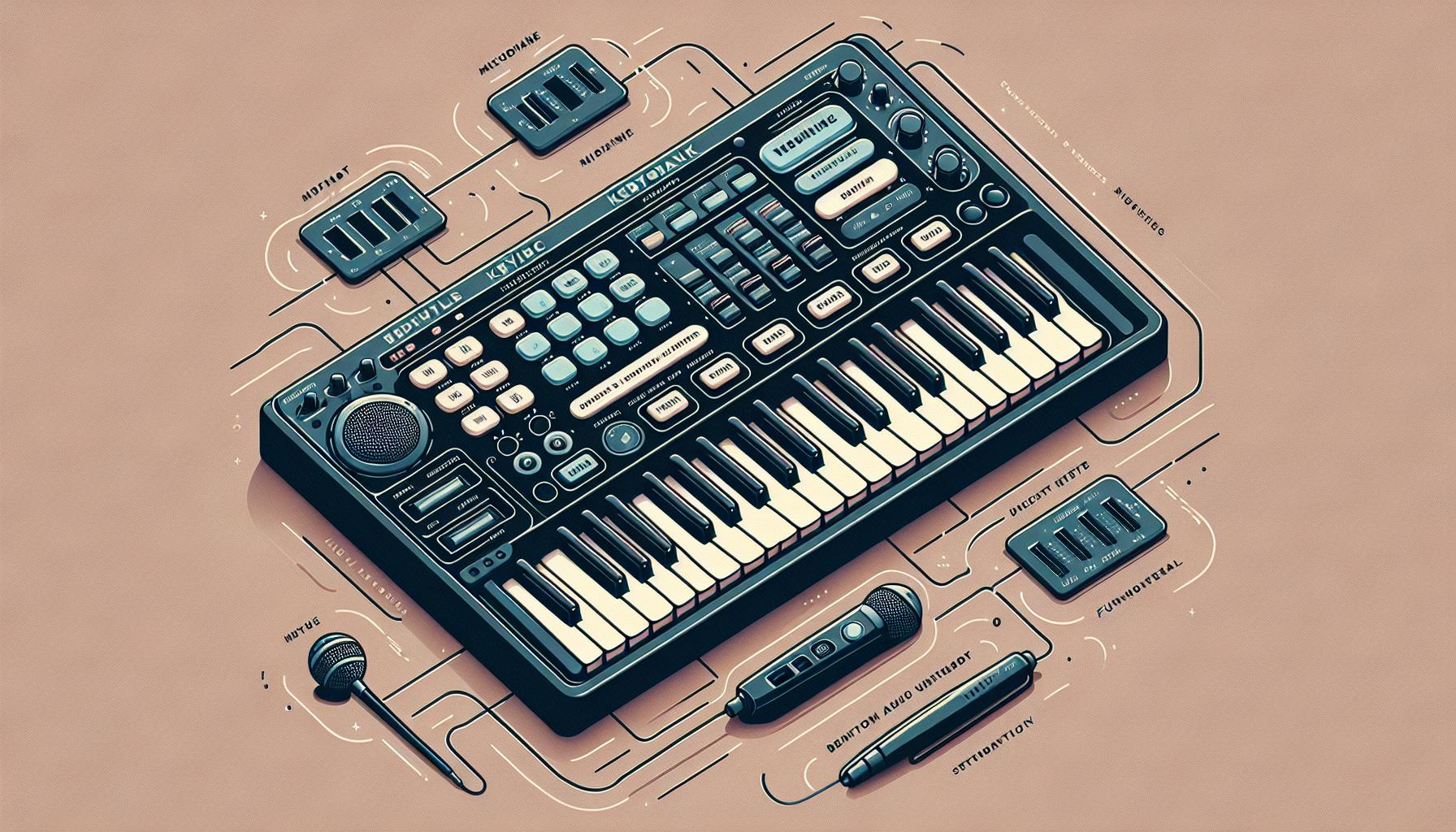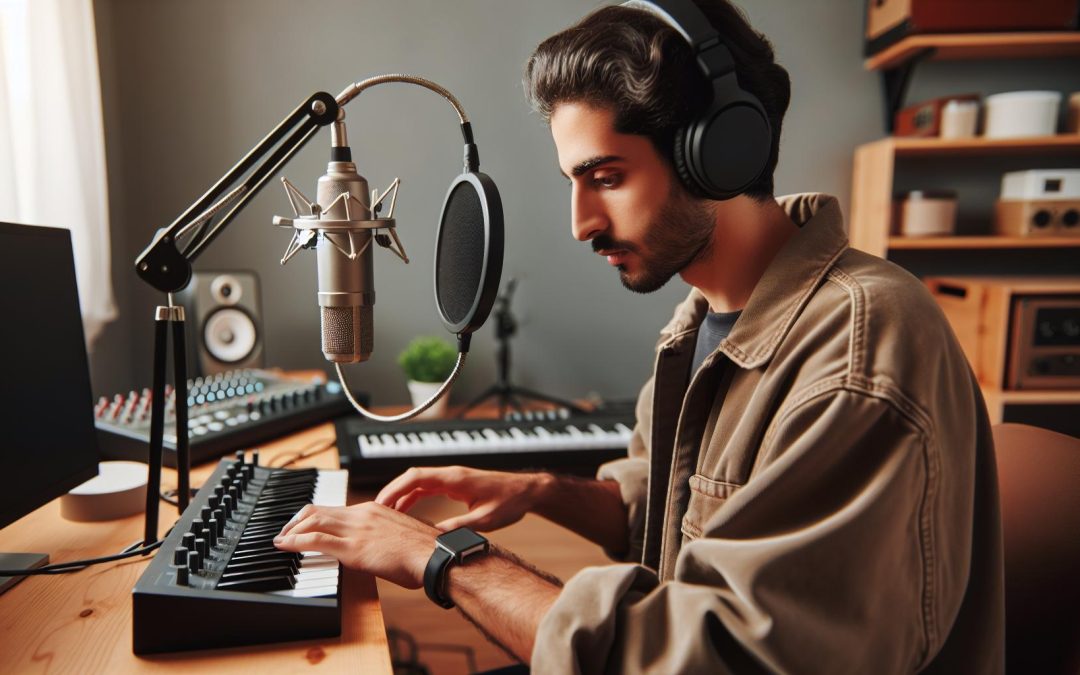In today's tech-savvy world, combining music with technology opens up a universe of creativity, especially for beginners. A keyboard with microphone input is a game-changer, offering an all-in-one solution for those eager to explore the realms of music and voice. It's not just about hitting the right notes; it's about adding your voice to the melody, creating something truly unique.
For beginners, the thought of navigating through the vast options of musical keyboards can be daunting. But fear not! There's a perfect match for everyone, from those just dipping their toes into the musical world to budding musicians ready to take their first step into recording and performance. Let's dive into the world of keyboards with microphone inputs, where every keystroke and vocal note opens the door to endless possibilities.
Benefits of a Keyboard with Microphone Input
When beginners choose a keyboard with a microphone input, they're not just investing in an instrument; they're opening the door to a world brimming with creative potential. This combination not only simplifies the setup required to explore both singing and playing but also encourages a more immersive experience in music creation.
One of the primary advantages is the ease of use. For those just stepping into the realm of music, complicated setups can be daunting. A keyboard with a built-in microphone input eliminates the need for multiple devices, making the initial foray into music creation as straightforward as possible. This simplicity ensures that beginners can focus on what matters most: learning and enjoying music.
Furthermore, the integration of a microphone input with a keyboard offers a significant benefit in versatility. It allows users to experiment with not just instrumental melodies but also to incorporate vocals. This duality can lead to a deeper understanding of how songs are structured and how instrumental and vocal harmonies complement each other.
The creativity boost that comes from the ability to easily add vocals to keyboard play cannot be overstated. Beginners find that they can experiment with different sounds, genres, and techniques, leading to a more rounded musical education. They aren't just practicing scales and chords; they're creating music that feels fully theirs, often leading to a more profound emotional connection to their work and a stronger motivation to continue learning.
Moreover, compatibility with learning and recording software adds another layer of convenience and potential. Many keyboards with microphone inputs can connect to computers and smartphones, enabling beginners to record their creations, share them, and even dive into the world of digital music production. This connectivity is crucial in the modern music-making landscape, offering a seamless transition from practice to performance or recording.
Lastly, value for money is a significant consideration. Equipment costs can quickly accumulate for those new to music. Opting for a keyboard with a microphone input is a cost-effective choice that provides a multifunctional tool for both learning music and experimenting with voice, eliminating the need for additional expensive gear.
| Advantage | Impact |
|---|---|
| Ease of Use | Simplifies setup, making music more accessible |
| Versatility | Encourages exploration of both instrumental and vocal music |
| Creativity Boost | Fuels experimentation and personal connection to music |
| Compatibility with Software |
Choosing the Right Keyboard for Beginners

When embarking on the musical journey, selecting the right keyboard is pivotal for beginners. The sheer variety of options available can be overwhelming. However, focusing on a few key features can simplify this process, ensuring the chosen instrument perfectly aligns with their aspirations and learning curve.
Firstly, keyboard size plays a crucial role. For beginners, a 61-key keyboard is often recommended. It provides ample range for exploring various musical genres without the intimidation of a full 88-key piano. This size strikes a balance, offering enough keys to learn, play most songs, and understand basic music theory, without overwhelming the user.
Touch sensitivity is another vital feature. Keyboards with touch-sensitive keys respond differently depending on how hard they're pressed, much like an acoustic piano. This feature is essential for beginners as it fosters dynamic playing and a more expressive performance, laying the groundwork for advanced techniques.
The inclusion of a microphone input cannot be overstated. This feature offers beginners the unique advantage of integrating vocals with their keyboard play. It allows them to experiment with singing while playing, which can be vastly beneficial for ear training and musical multitasking. Moreover, a microphone input paves the way for engaging in digital music production, offering a glimpse into the world of music technology.
Moreover, considering preloaded sounds and rhythms can greatly enhance a beginner's learning experience. Keyboards equipped with a variety of instrumental sounds, from strings to percussion, and built-in rhythms or drum patterns stimulate creativity. They invite users to explore different music styles and understand various musical structures. For beginners, this exploration is key to finding their musical preferences and inspiring continuous learning.
Connectivity options such as MIDI or USB ports are equally important. They allow the keyboard to connect to a computer or mobile device, opening up a plethora of learning and recording software options. This compatibility not only aids in practicing and composing but also in sharing music, receiving feedback, and participating in online learning communities.
Lastly, durability and portability should be considered. For beginners, especially younger players or those who might need to transport their instrument to lessons or performances, having a robust yet lightweight keyboard is beneficial. It ensures the instrument can withstand the initial learning phase and any travels it might accompany its player on.
Exploring Features and Functions

When delving into the world of music keyboards, especially for beginners, one can't help but be amazed by the plethora of features and functions available. Among these, a keyboard with a microphone input stands out as an incredibly versatile tool. This feature not only promotes the integration of singing and playing but also paves the way for exciting opportunities in music education and creative expression.
Keyboards tailored for beginners often come equipped with a range of functions designed to enhance the learning experience. Touch sensitivity is a prime example. This function, which allows the volume of the note to change depending on how hard the key is pressed, is crucial for developing dynamic playing skills. It teaches beginners the nuances of expressive playing, laying a foundation for more advanced techniques.
Another significant feature is the array of preloaded sounds and rhythms. For learners, this is akin to having a whole orchestra at their fingertips. It enables them to explore various musical styles, from classical to pop, jazz to electronic. This exploration is not just fun but educational, broadening their musical horizons and keeping the learning process engaging.
Connectivity options like MIDI or USB ports are like gateways to the digital music world. They allow the keyboard to connect to computers or tablets, giving beginners access to a vast array of music learning and production software. This connectivity fosters a deeper understanding of music theory, composition, and arrangement, making it an invaluable feature for those keen on delving into music production or simply wanting to record their progress.
The importance of durability and portability cannot be overstated. For beginners, especially younger learners, a keyboard that can withstand the rigors of regular practice and is easy to transport is crucial. It ensures that the instrument remains a constant companion, whether at home, in the classroom, or on stage.
| Feature | Importance |
|---|---|
| Microphone Input | Allows for vocal integration, aiding in ear training and digital music production. |
| Touch Sensitivity | Enhances dynamic playing, teaching the nuances of expressive playing. |
| Preloaded Sounds and Rhythms | Encourages exploration of different music styles, keeping learning engaging. |
| MIDI/USB Connectivity | Facilitates connection to learning and recording software, deepening music theory understanding. |
| Durability and Portability | Ensures the keyboard withstands regular use and is easy to transport for lessons or performances. |
Tips for Using the Microphone Input Effectively

Integrating a microphone into keyboard practice sessions can transform the learning experience for beginners. It not only allows them to accompany their own singing or speaking but also opens up a myriad of creative possibilities. Here are some invaluable tips for beginners to make the most out of their keyboard's microphone input.
Firstly, they should ensure the microphone is compatible with their keyboard. Most keyboards with a microphone input require a specific type of microphone, usually a dynamic mic, which is known for its durability and ability to handle high sound pressure levels. Checking the keyboard's manual for compatibility and connection guidelines is a wise first step.
Positioning the microphone correctly is crucial. It should be placed at a comfortable distance where it can clearly capture the voice without any distortion or unwanted noise. Beginners might need to experiment with different positions to find the sweet spot where their vocals blend seamlessly with the sound of the keyboard.
Adjusting the volume levels is another key factor. The balance between the microphone and keyboard’s volume should be such that neither overpowers the other. Beginners should start with lower volumes, gradually increasing them to reach the desired mix where their voice harmonizes with the music.
Moreover, engaging with the built-in features of the keyboard can enrich the learning and performing experience. Many keyboards come with effects like reverb or echo that can enhance vocals. Experimenting with these effects can not only make practicing more enjoyable but also help in understanding how to layer sounds effectively.
Exploring the range of genres and songs that incorporate keyboard and vocals is also beneficial. This can inspire beginners and help them discover the styles that resonate most with them, encouraging consistent practice and exploration.
Lastly, recording sessions can be incredibly valuable. Most modern keyboards with a microphone input offer recording capabilities. Listening back to these recordings can provide beginners with feedback on their progress, highlight areas for improvement, and boost their confidence.
In essence, using the microphone input effectively comes down to experimentation, practice, and creative exploration. These tips aim to enhance the learning journey for beginners as they embark on the exciting path of integrating singing or speaking into their keyboard play.
Setting Up for Recording and Performance

Setting up for recording and performance with a keyboard that features a microphone input can initially seem daunting for beginners. However, with a few straightforward steps, they'll quickly find themselves creating music that not only sounds great but feels professionally done.
The first step is ensuring that all the necessary equipment is in place. This includes the keyboard itself, a compatible microphone, and, if required, an audio interface to connect the microphone to the keyboard. For keyboards that don't support direct microphone input, an audio interface acts as a bridge, ensuring the microphone's sound can be incorporated seamlessly.
Next, positioning is key. Beginners should place the microphone close enough to capture their voice clearly but at a distance that prevents popping sounds or breathing noises from being too prominent. It's a delicate balance that is often found through trial and error. Equally, the keyboard should be positioned in a comfortable place, allowing for easy access to its controls during performance or recording.
Volume levels are another crucial consideration. They need to adjust the volume of both the microphone and the keyboard to achieve a harmonious blend of vocals and instrumentals. This might mean turning down the volume of the keyboard to allow the vocals to shine through or vice versa, depending on the desired effect.
After these preparations, it's time to dive into the built-in recording features most keyboards with microphone inputs offer. They should familiarize themselves with the recording process, understanding how to start, pause, and stop recording as needed. This understanding enables them to capture their performances effectively, allowing for immediate playback and evaluation.
Experimentation plays a significant role in this stage. They're encouraged to try recording different genres of music, incorporating the use of built-in effects, and even layering multiple vocal tracks if possible. This exploration not only enhances their skill set but also aids in discovering their unique sound.
For those aiming to perform live, it's essential to practice with the microphone and keyboard setup just as they would during a performance. This means running through their set, making any necessary adjustments to their setup, and becoming comfortable with the transitions between speaking or singing and playing.
Additionally, they should not overlook the importance of sound checks before a live performance. This involves testing the microphone and keyboard setup on the actual performance sound system to ensure everything works perfectly and adjusting the sound levels as needed to suit the venue.
Conclusion
Venturing into the world of keyboards with microphone inputs opens up a new realm of musical exploration for beginners. With the right setup and a bit of practice, anyone can blend instrumental and vocal performances seamlessly. Remember the importance of experimenting with your sound and the value of consistent practice. Whether you're aiming for recording or live performances, mastering the art of balance between your keyboard and microphone will elevate your music. So grab your gear, dive into the creative process, and let your unique sound resonate.
Harlan Kilstein began playing piano during covid with no piano background at all. He taught himself how to play learning what to do and what not to do.
Today he's an advanced intermediate player and can help you grow in your skills because he learned all this on his own.








